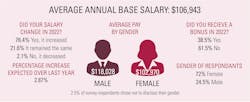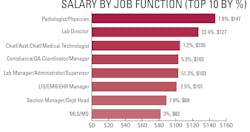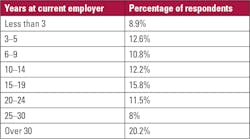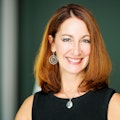MLO’s 2023 salary survey of laboratory professionals
The results of Medical Laboratory Observer’s 2023 annual salary survey of laboratory professionals indicated that the average salary has increased, most are satisfied with their jobs, and job security remains high; however, 83 percent of respondents noted that staffing shortages have had a “moderate to large impact” on operational efficiency.
Of the 436 survey respondents, the majority were female (72.9 percent), 24.5 percent were male, and 2.5 percent preferred not to answer. Most respondents were 46–65 years old. And the vast majority of respondents (97 percent) work in hospital laboratories in a management position. We will make comparisons between the 2023 and 2022 surveys, but the sample sizes are very different as almost twice as many responded to this year’s survey over last year’s.Average salary increases
The average compensation of a laboratory professional rose by $14,792 from the 2022 to 2023 surveys: $92,146 in 2022 to $106,938 in 2023. This year, the average salary of female respondents is $102,970, and the average salary of male respondents is $118,028. Certain laboratory positions experienced a significant increase in average salary, while others experienced a moderate increase or stayed fairly the same. The positions that showed the highest average increases were as follows:
Positions that experienced a moderate increase from 2022 to 2023 include lab director — $123,500 in 2022 to $126,531 in 2023 and section manager/department head — $83,735 in 2022 to $88,647 in 2023; and clinical laboratory scientist — $69,500 in 2022 to $71,250 in 2023. Position salaries that stayed fairly the same were pathologist/physician ($147,313) and microbiologist ($70,357).
The three regions with the highest average salaries were the Pacific ($137,893), Southeast ($109,612), and Northeast ($108,236).Lab size and testing volume
Respondents were spread pretty evenly across lab sizes, and their salaries reflect the size of lab they work in, i.e., lab professionals working in larger labs continue to earn higher salaries. Among those who work in laboratories with more than 100 employees, the average salary is $122,103. The average salary for those working in labs with 51–100 employees is $114,328; 21–50 employees is $102,439; 11–20 employees is $96,174; and 1–10 employees is $85,113.
Annual volume of tests does not exactly follow the same trend as lab size and salary, though significant increases are seen from last year to this year.
Employer benefits
The 2023 benefits for laboratory professionals are similar to the 2022 salary survey benefits. Nearly all respondents receive health insurance, dental insurance, vision insurance, and a 401(k) or pension plan. A significant proportion of respondents receive life insurance (88 percent), paid time off (86 percent), and disability insurance (76 percent).
Benefits that decreased from 2022 to 2023 are overtime pay (33 percent in 2023; 45 percent in 2022), bonuses (28 percent in 2023; 33 percent in 2022), and paid COVID leave (20 percent in 2023; 31 percent in 2022). The least common benefits in 2023 are flextime (13 percent) and child care (6 percent).
Challenges and opportunities
Since the pandemic, staffing shortages have been one of the primary topics in the healthcare field. In 2023, most respondents indicated that the current shortages have had a moderate to large impact on their operational efficiency. This year, 46.1 percent indicated moderate impact and 37.2 percent indicated large impact. The degree of impact has gone down from last year when the numbers indicated 43.2 percent large impact and 40.3 percent moderate impact.
The percentages have remained relatively stable on laboratories outsourcing tests due to staffing shortages: 73.9 percent indicated “no” in 2023 and 26.1 percent “yes.” In 2022, it was 71.6 percent “no” and 28.4 percent “yes.”
The biggest changes in today’s clinical laboratory are automation, artificial intelligence, and digital pathology. These technological changes are making lab operations more efficient and effective. However, the number of laboratories automating new procedures this past year has decreased but laboratorians’ awareness of these changes in their lab has increased.Degrees, certifications, and continuing education
The majority of lab professionals hold bachelor’s or post-graduate degrees, at 57 percent and 38 percent respectively. Those with associate degrees are at 5 percent. As expected, one’s salary is connected to their education. The average salary of a lab professional with a post-graduate degree is $121,277, bachelor’s degree is $100,374, and associate degree is $72,167.
Most respondents hold a medical laboratory scientist (MLS) or medical laboratory technician (MLT) certification from the American Society for Clinical Pathology (ASCP) Board of Certification (BOC), followed by certification through a state or the American Medical Technologists.
As for continuing education, 33.5 percent of respondents earned between 11–20 hours of continuing education credits in 2023, and 18.6 percent earned over 20 hours of continuing education credits. Those earning 10 or less hours spread from varying percentages of 1 percent to 9 percent.
When asked how satisfied they are with their lab’s education and training programs, 52.5 percent indicated somewhat satisfied, 22.9 percent indicated somewhat dissatisfied, 17 percent indicated very satisfied, and 7.6 percent indicated very dissatisfied.
Job security, satisfaction, and tenure
Lab professionals feel a little less secure with their job positions this year with 56.9 percent indicating very secure (60.5 percent in 2022) and 37.6 percent indicating somewhat secure (35 percent in 2022). Job satisfaction rates are similar this year to last year. In 2023, 53.2 percent are somewhat satisfied (50.2 percent in 2022), 30.3 percent are very satisfied (32.1 percent in 2022), 13.5 percent are somewhat dissatisfied (13.2 percent in 2022), and 3 percent are very dissatisfied (4.5 percent in 2022).
There is significant longevity in the lab professions: 53.2 percent of respondents have been in the lab industry over 30 years, 14.9 percent 25–30 years, and 10.6 percent 20–24 years. Respondents were pretty evenly spread for their years at their current employers; however, 20.2 percent of respondents have been with their current employer over 30 years!






